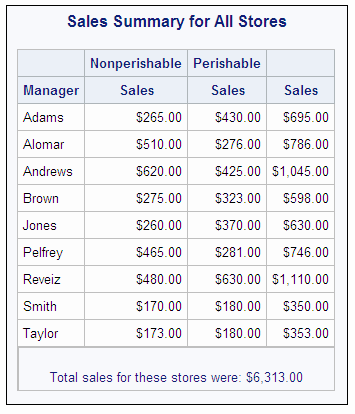REPORT Procedure
- Syntax

- Overview
- Concepts
- Using
- Results
- Examples
 Selecting Variables for a ReportOrdering the Rows in a ReportUsing Aliases to Obtain Multiple Statistics for the Same VariableConsolidating Multiple Observations into One Row of a ReportCreating a Column for Each Value of a VariableDisplaying Multiple Statistics for One VariableStoring and Reusing a Report DefinitionCondensing a Report into Multiple PanelsWriting a Customized Summary on Each PageCalculating PercentagesHow PROC REPORT Handles Missing ValuesCreating and Processing an Output Data SetStoring Computed Variables as Part of a Data SetUsing a Format to Create GroupsSpecifying Style Elements for ODS Output in the PROC REPORT StatementSpecifying Style Elements for ODS Output in Multiple StatementsUsing Multilabel FormatsUsing the WIDTH= and CELLWIDTH= Style Attributes with PROC REPORT
Selecting Variables for a ReportOrdering the Rows in a ReportUsing Aliases to Obtain Multiple Statistics for the Same VariableConsolidating Multiple Observations into One Row of a ReportCreating a Column for Each Value of a VariableDisplaying Multiple Statistics for One VariableStoring and Reusing a Report DefinitionCondensing a Report into Multiple PanelsWriting a Customized Summary on Each PageCalculating PercentagesHow PROC REPORT Handles Missing ValuesCreating and Processing an Output Data SetStoring Computed Variables as Part of a Data SetUsing a Format to Create GroupsSpecifying Style Elements for ODS Output in the PROC REPORT StatementSpecifying Style Elements for ODS Output in Multiple StatementsUsing Multilabel FormatsUsing the WIDTH= and CELLWIDTH= Style Attributes with PROC REPORT
Example 14: Using a Format to Create Groups
| Features: |
DEFINE statement options: GROUP |
| Other features: |
FORMAT procedure |
| Data set: | GROCERY |
| Format: | $MGRFMT |
Details
This example shows how
to use formats to control the number of groups that PROC REPORT creates.
The program creates a format for Department that classifies the four
departments as one of two types: perishable or nonperishable. Consequently,
when Department is an across variable, PROC REPORT creates only two
columns instead of four. The column heading is the formatted value
of the variable.
Program
libname proclib
'SAS-library';
options fmtsearch=(proclib);
proc format;
value $perish 'p1','p2'='Perishable'
'np1','np2'='Nonperishable';
run;
proc report data=grocery nowd
headline
headskip;
column manager department,sales sales;
define manager / group order=formatted
format=$mgrfmt.;
define department / across order=formatted
format=$perish. '';
define sales / analysis sum
format=dollar9.2 width=13;
compute after;
line ' ';
line 'Total sales for these stores were: '
sales.sum dollar9.2;
endcomp;
title 'Sales Summary for All Stores'; run;
Program Description
Specify the format search library.The SAS system option FMTSEARCH= adds the SAS library
PROCLIB to the search path that is used to locate formats.
Create the $PERISH. format. PROC
FORMAT creates a format for Department. This variable has four different
values in the data set, but the format has only two values.
Specify the report options. The
NOWD option runs the REPORT procedure without the REPORT window and
sends its output to the open output destinations. HEADLINE underlines
all column headings and the spaces between them at the top of each
page of the report. HEADSKIP
writes a blank line beneath the underlining that HEADLINE writes.
Specify the report columns. Department
and Sales are separated by a comma in the COLUMN statement, so they
collectively determine the contents of the column that they define.
Because Sales is an analysis variable, its values fill the cells that
are created by these two variables. The report also contains a column
for Manager and a column for Sales by itself (which is the sales for
all departments).
Define the group and across variables. Manager is a group variable. Each detail row of
the report consolidates the information for all observations with
the same value of Manager. Department is an across variable. PROC
REPORT creates a column and a column heading for each formatted value
of Department. ORDER=FORMATTED arranges the values of Manager and
Department alphabetically according to their formatted values. FORMAT=
specifies the formats to use. The empty quotation marks in the definition
of Department specify a blank column heading, so no heading spans
all the departments. However, PROC REPORT uses the formatted values
of Department to create a column heading for each individual department.
define manager / group order=formatted
format=$mgrfmt.;
define department / across order=formatted
format=$perish. '';Define the analysis variable. Sales
is an analysis variable that is used to calculate the Sum statistic.
Sales appears twice in the COLUMN statement, and the same definition
applies to both occurrences. FORMAT= specifies the format to use in
the report. WIDTH= specifies the width of the column. Notice that
the column headings for the columns that both Department and Sales
create are a combination of the heading for Department and the (default)
heading for Sales.
